TOYOTA LAND CRUISER 2012 Owners Manual
Manufacturer: TOYOTA, Model Year: 2012, Model line: LAND CRUISER, Model: TOYOTA LAND CRUISER 2012Pages: 692, PDF Size: 29.3 MB
Page 301 of 692
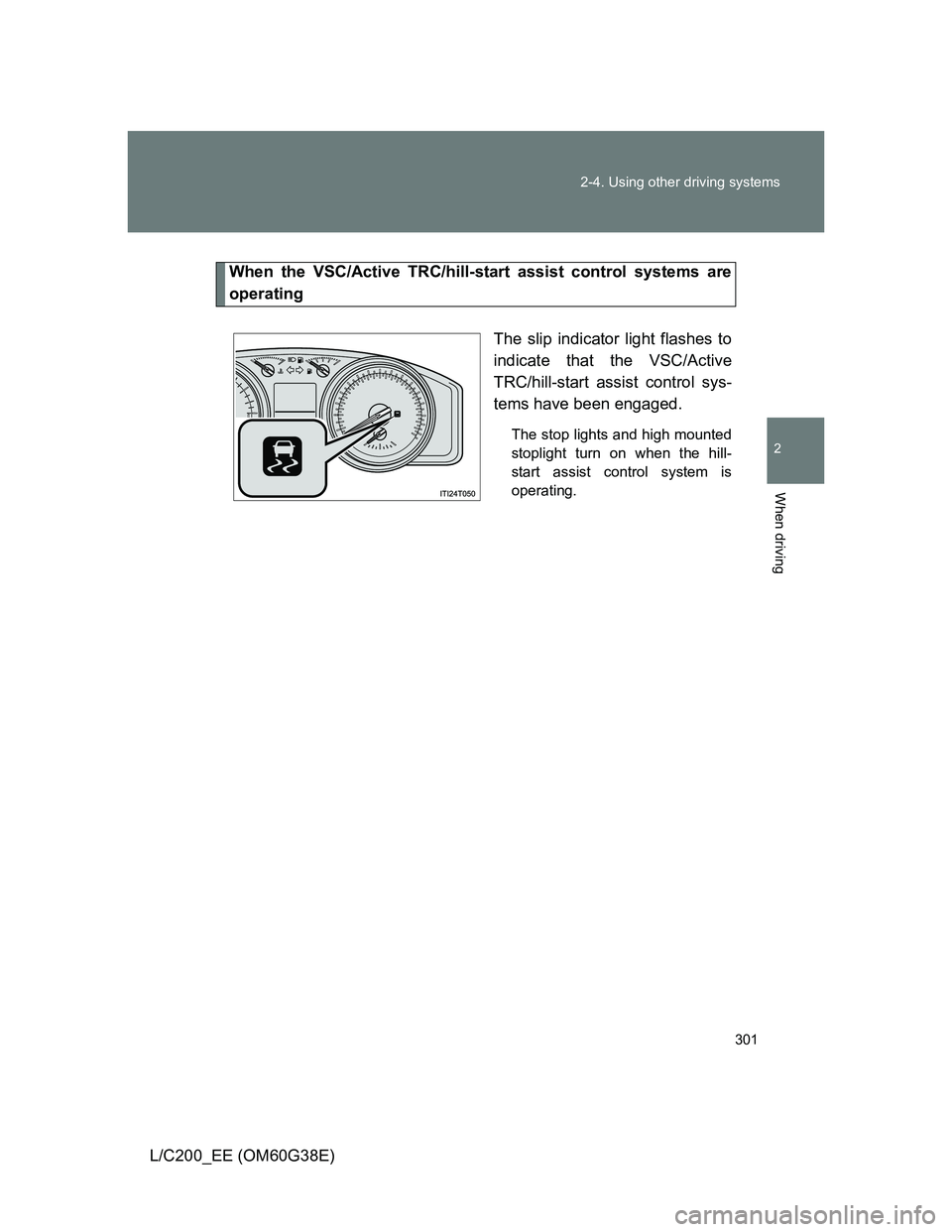
301 2-4. Using other driving systems
2
When driving
L/C200_EE (OM60G38E)
When the VSC/Active TRC/hill-start assist control systems are
operating
The slip indicator light flashes to
indicate that the VSC/Active
TRC/hill-start assist control sys-
tems have been engaged.
The stop lights and high mounted
stoplight turn on when the hill-
start assist control system is
operating.
Page 302 of 692
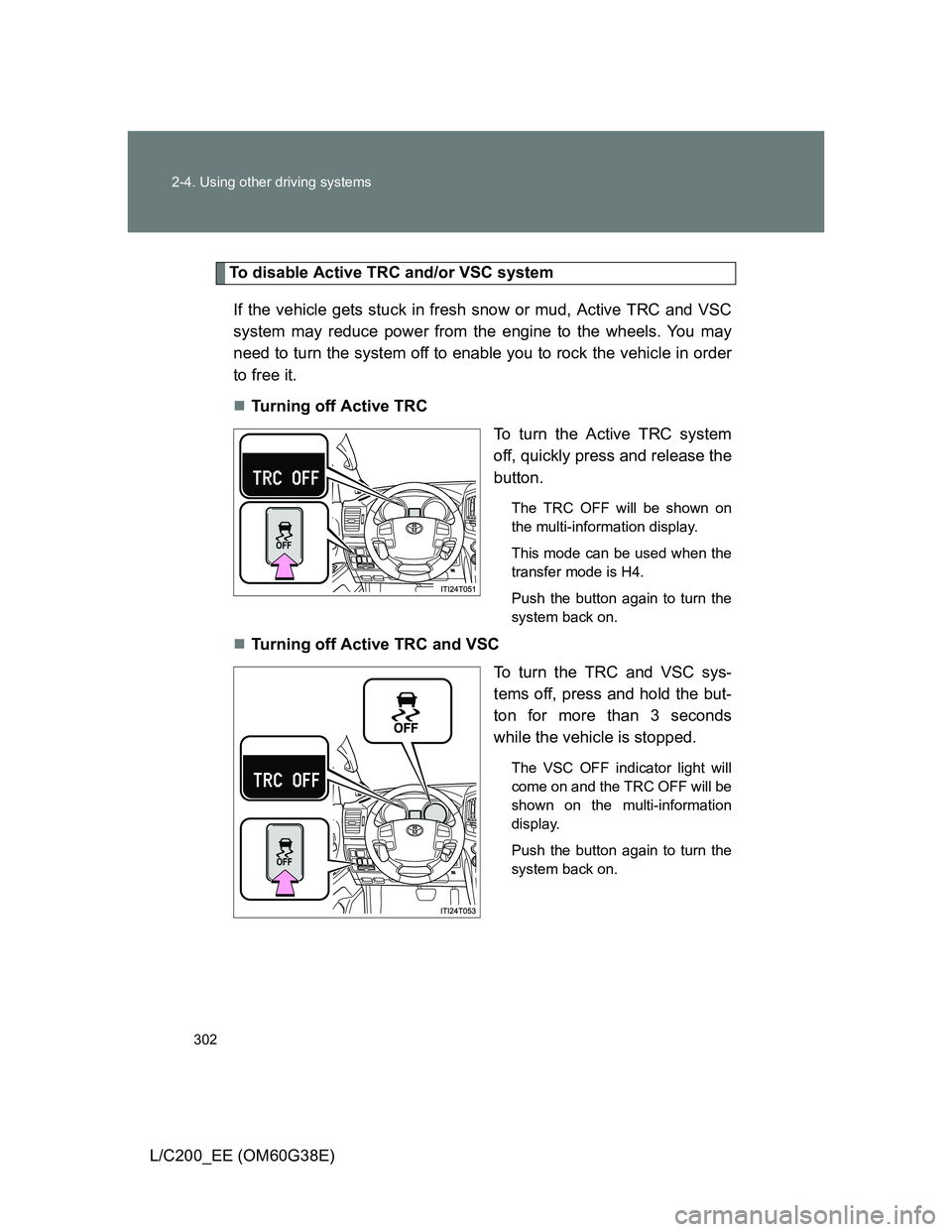
302 2-4. Using other driving systems
L/C200_EE (OM60G38E)
To disable Active TRC and/or VSC system
If the vehicle gets stuck in fresh snow or mud, Active TRC and VSC
system may reduce power from the engine to the wheels. You may
need to turn the system off to enable you to rock the vehicle in order
to free it.
Turning off Active TRC
To turn the Active TRC system
off, quickly press and release the
button.
The TRC OFF will be shown on
the multi-information display.
This mode can be used when the
transfer mode is H4.
Push the button again to turn the
system back on.
Turning off Active TRC and VSC
To turn the TRC and VSC sys-
tems off, press and hold the but-
ton for more than 3 seconds
while the vehicle is stopped.
The VSC OFF indicator light will
come on and the TRC OFF will be
shown on the multi-information
display.
Push the button again to turn the
system back on.
Page 303 of 692
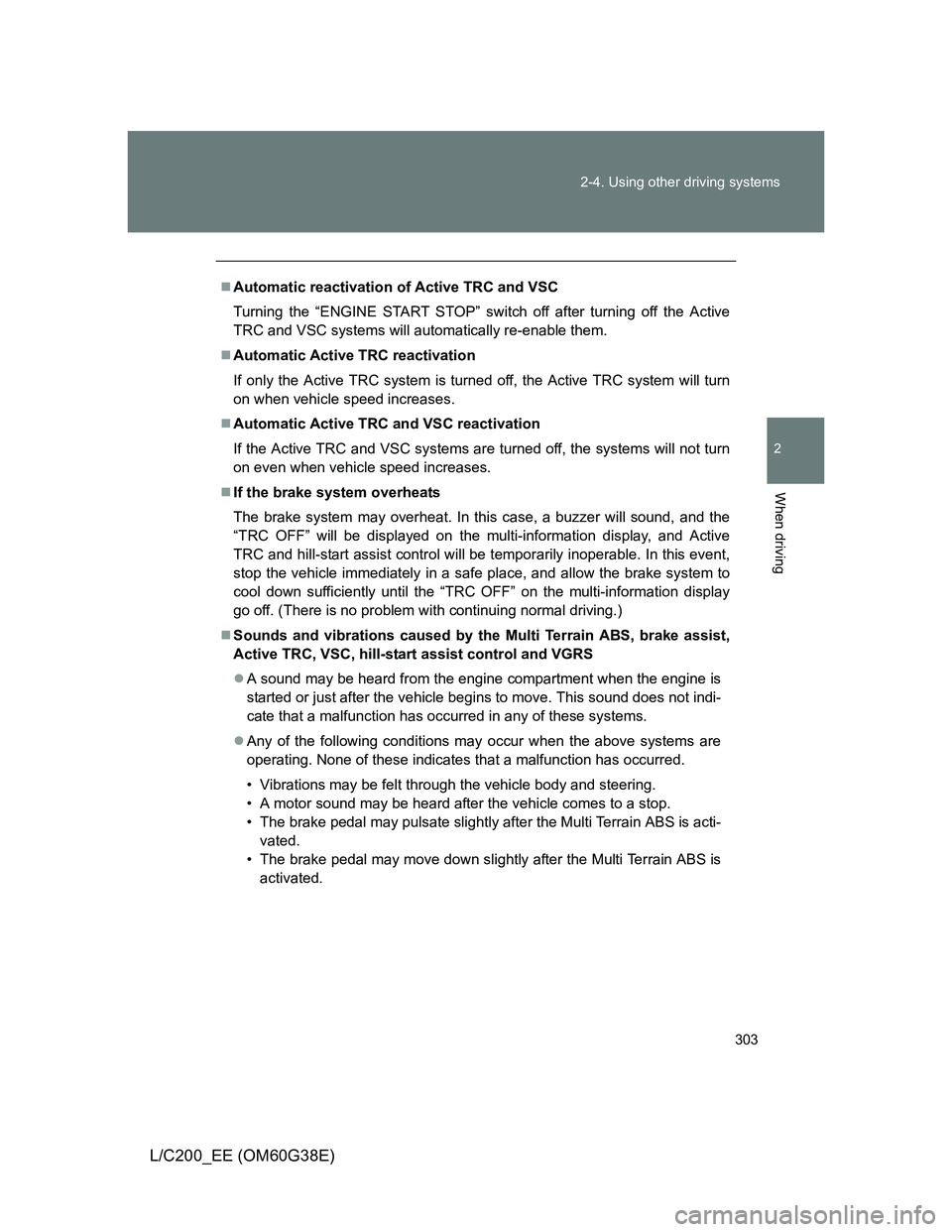
303 2-4. Using other driving systems
2
When driving
L/C200_EE (OM60G38E)
Automatic reactivation of Active TRC and VSC
Turning the “ENGINE START STOP” switch off after turning off the Active
TRC and VSC systems will automatically re-enable them.
Automatic Active TRC reactivation
If only the Active TRC system is turned off, the Active TRC system will turn
on when vehicle speed increases.
Automatic Active TRC and VSC reactivation
If the Active TRC and VSC systems are turned off, the systems will not turn
on even when vehicle speed increases.
If the brake system overheats
The brake system may overheat. In this case, a buzzer will sound, and the
“TRC OFF” will be displayed on the multi-information display, and Active
TRC and hill-start assist control will be temporarily inoperable. In this event,
stop the vehicle immediately in a safe place, and allow the brake system to
cool down sufficiently until the “TRC OFF” on the multi-information display
go off. (There is no problem with continuing normal driving.)
Sounds and vibrations caused by the Multi Terrain ABS, brake assist,
Active TRC, VSC, hill-start assist control and VGRS
A sound may be heard from the engine compartment when the engine is
started or just after the vehicle begins to move. This sound does not indi-
cate that a malfunction has occurred in any of these systems.
Any of the following conditions may occur when the above systems are
operating. None of these indicates that a malfunction has occurred.
• Vibrations may be felt through the vehicle body and steering.
• A motor sound may be heard after the vehicle comes to a stop.
• The brake pedal may pulsate slightly after the Multi Terrain ABS is acti-
vated.
• The brake pedal may move down slightly after the Multi Terrain ABS is
activated.
Page 304 of 692
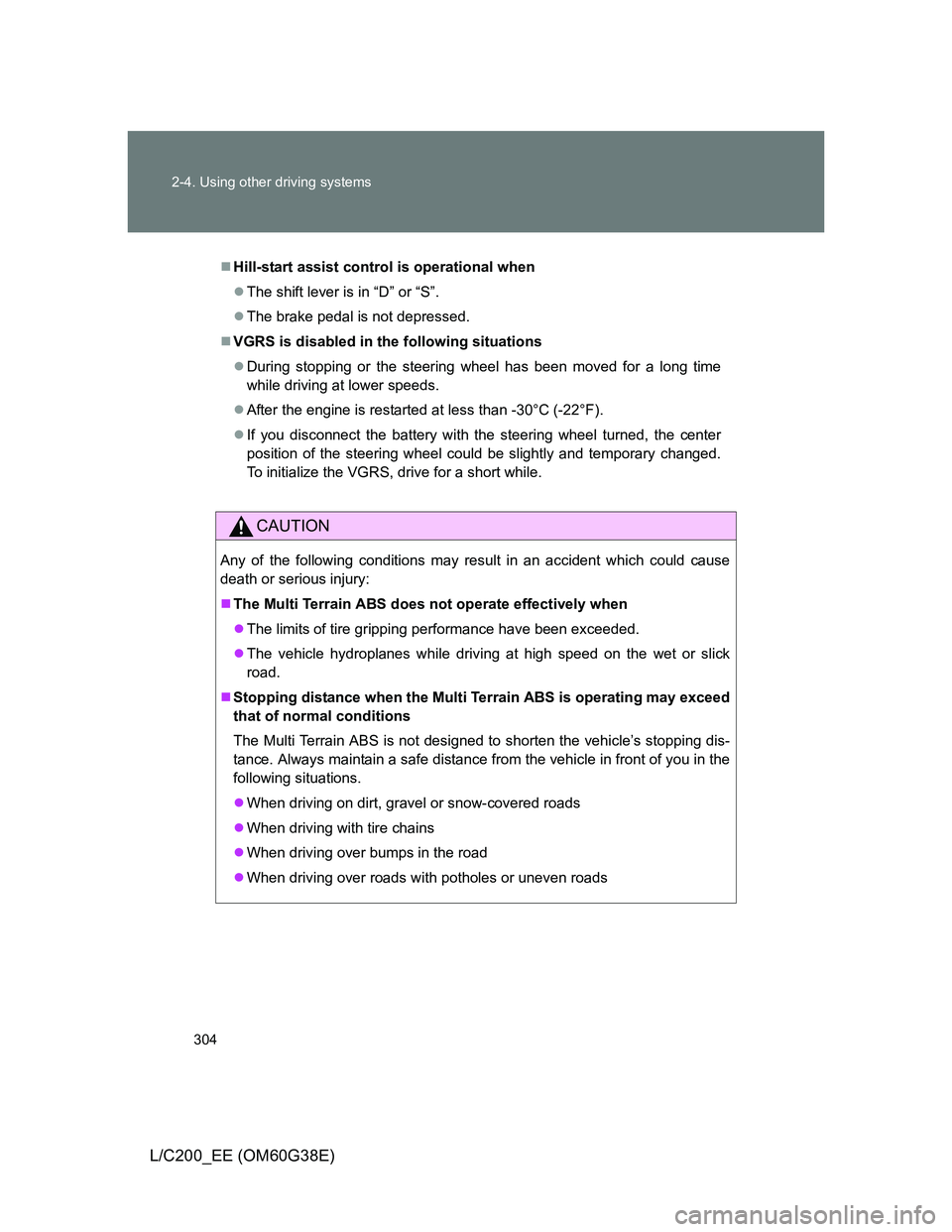
304 2-4. Using other driving systems
L/C200_EE (OM60G38E)
Hill-start assist control is operational when
The shift lever is in “D” or “S”.
The brake pedal is not depressed.
VGRS is disabled in the following situations
During stopping or the steering wheel has been moved for a long time
while driving at lower speeds.
After the engine is restarted at less than -30°C (-22°F).
If you disconnect the battery with the steering wheel turned, the center
position of the steering wheel could be slightly and temporary changed.
To initialize the VGRS, drive for a short while.
CAUTION
Any of the following conditions may result in an accident which could cause
death or serious injury:
The Multi Terrain ABS does not operate effectively when
The limits of tire gripping performance have been exceeded.
The vehicle hydroplanes while driving at high speed on the wet or slick
road.
Stopping distance when the Multi Terrain ABS is operating may exceed
that of normal conditions
The Multi Terrain ABS is not designed to shorten the vehicle’s stopping dis-
tance. Always maintain a safe distance from the vehicle in front of you in the
following situations.
When driving on dirt, gravel or snow-covered roads
When driving with tire chains
When driving over bumps in the road
When driving over roads with potholes or uneven roads
Page 305 of 692
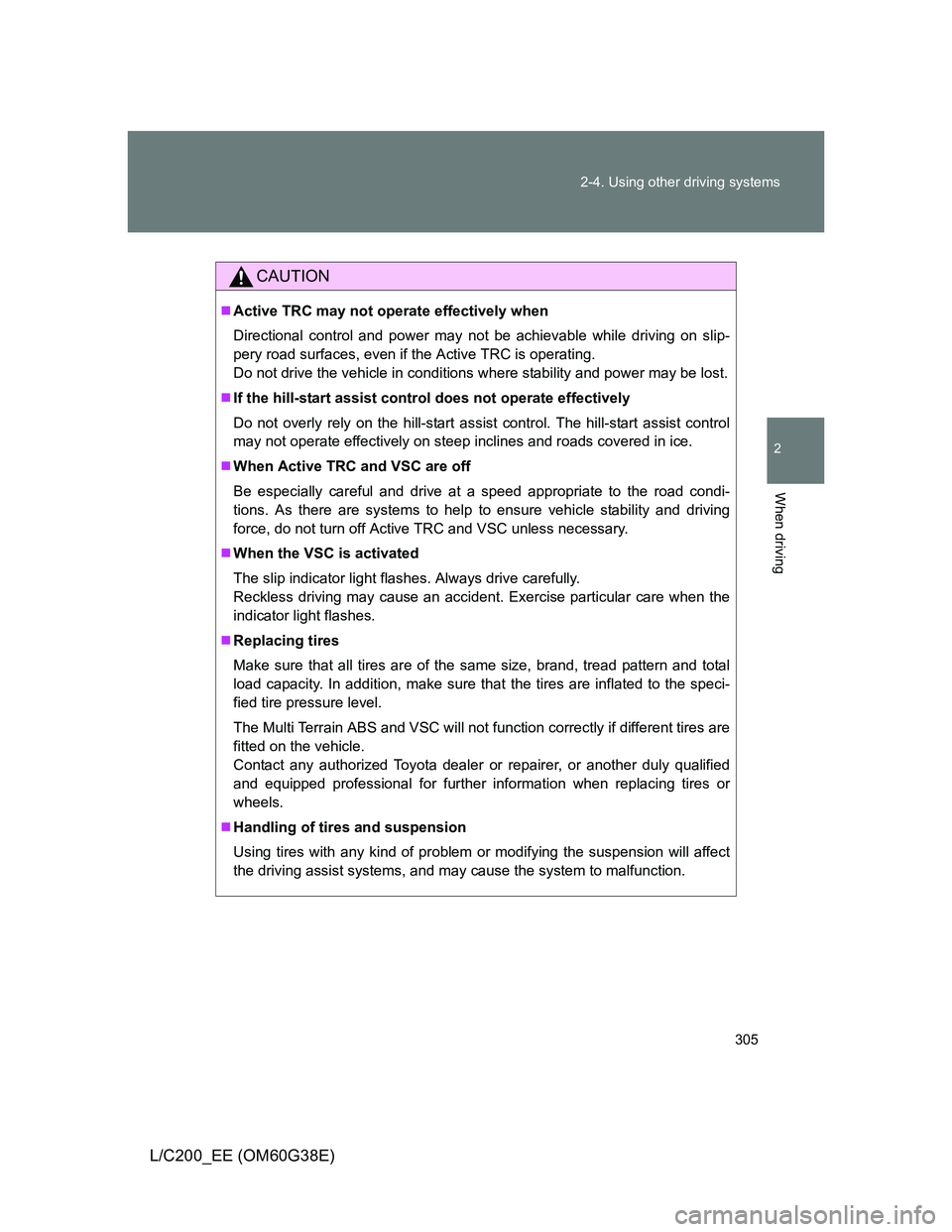
305 2-4. Using other driving systems
2
When driving
L/C200_EE (OM60G38E)
CAUTION
Active TRC may not operate effectively when
Directional control and power may not be achievable while driving on slip-
pery road surfaces, even if the Active TRC is operating.
Do not drive the vehicle in conditions where stability and power may be lost.
If the hill-start assist control does not operate effectively
Do not overly rely on the hill-start assist control. The hill-start assist control
may not operate effectively on steep inclines and roads covered in ice.
When Active TRC and VSC are off
Be especially careful and drive at a speed appropriate to the road condi-
tions. As there are systems to help to ensure vehicle stability and driving
force, do not turn off Active TRC and VSC unless necessary.
When the VSC is activated
The slip indicator light flashes. Always drive carefully.
Reckless driving may cause an accident. Exercise particular care when the
indicator light flashes.
Replacing tires
Make sure that all tires are of the same size, brand, tread pattern and total
load capacity. In addition, make sure that the tires are inflated to the speci-
fied tire pressure level.
The Multi Terrain ABS and VSC will not function correctly if different tires are
fitted on the vehicle.
Contact any authorized Toyota dealer or repairer, or another duly qualified
and equipped professional for further information when replacing tires or
wheels.
Handling of tires and suspension
Using tires with any kind of problem or modifying the suspension will affect
the driving assist systems, and may cause the system to malfunction.
Page 306 of 692
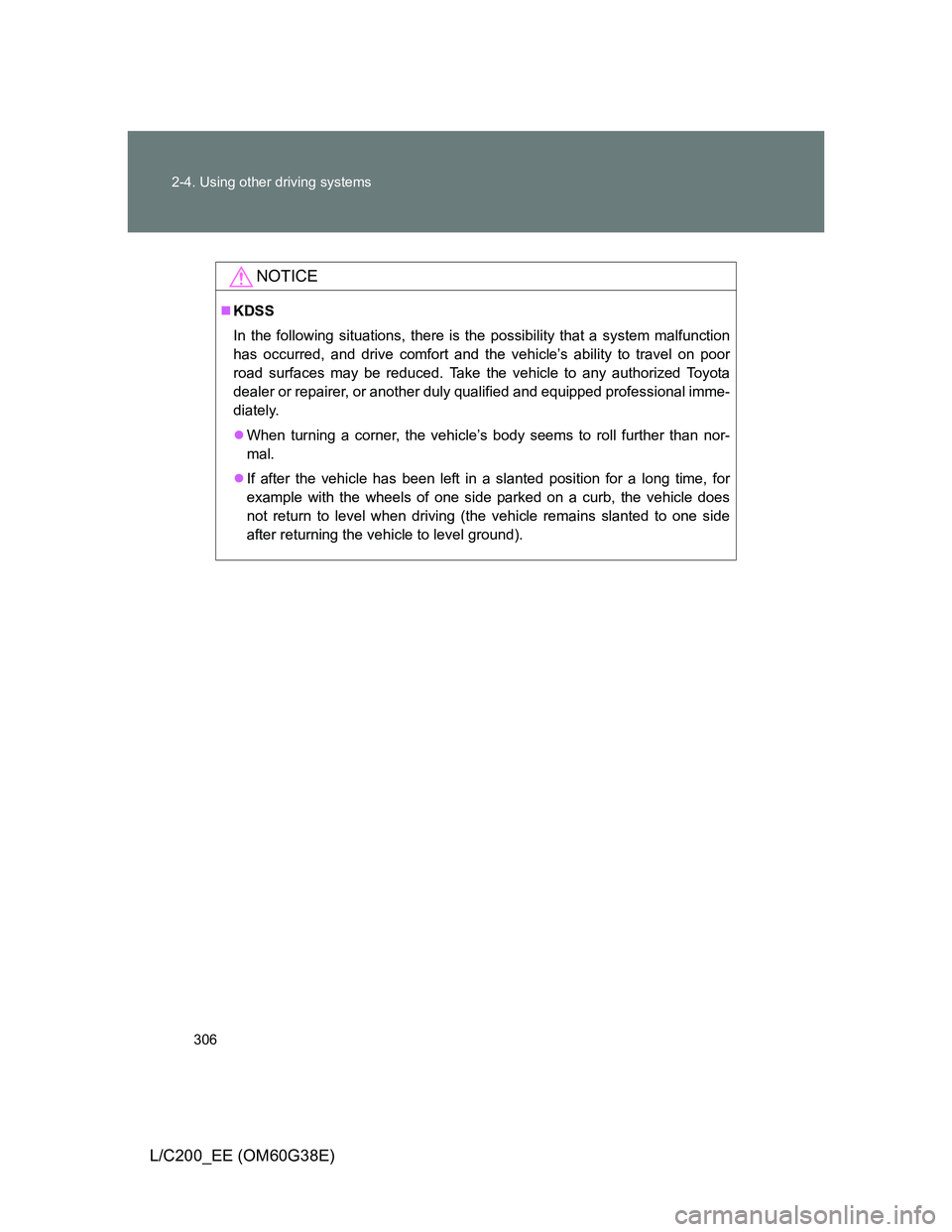
306 2-4. Using other driving systems
L/C200_EE (OM60G38E)
NOTICE
KDSS
In the following situations, there is the possibility that a system malfunction
has occurred, and drive comfort and the vehicle’s ability to travel on poor
road surfaces may be reduced. Take the vehicle to any authorized Toyota
dealer or repairer, or another duly qualified and equipped professional imme-
diately.
When turning a corner, the vehicle’s body seems to roll further than nor-
mal.
If after the vehicle has been left in a slanted position for a long time, for
example with the wheels of one side parked on a curb, the vehicle does
not return to level when driving (the vehicle remains slanted to one side
after returning the vehicle to level ground).
Page 307 of 692
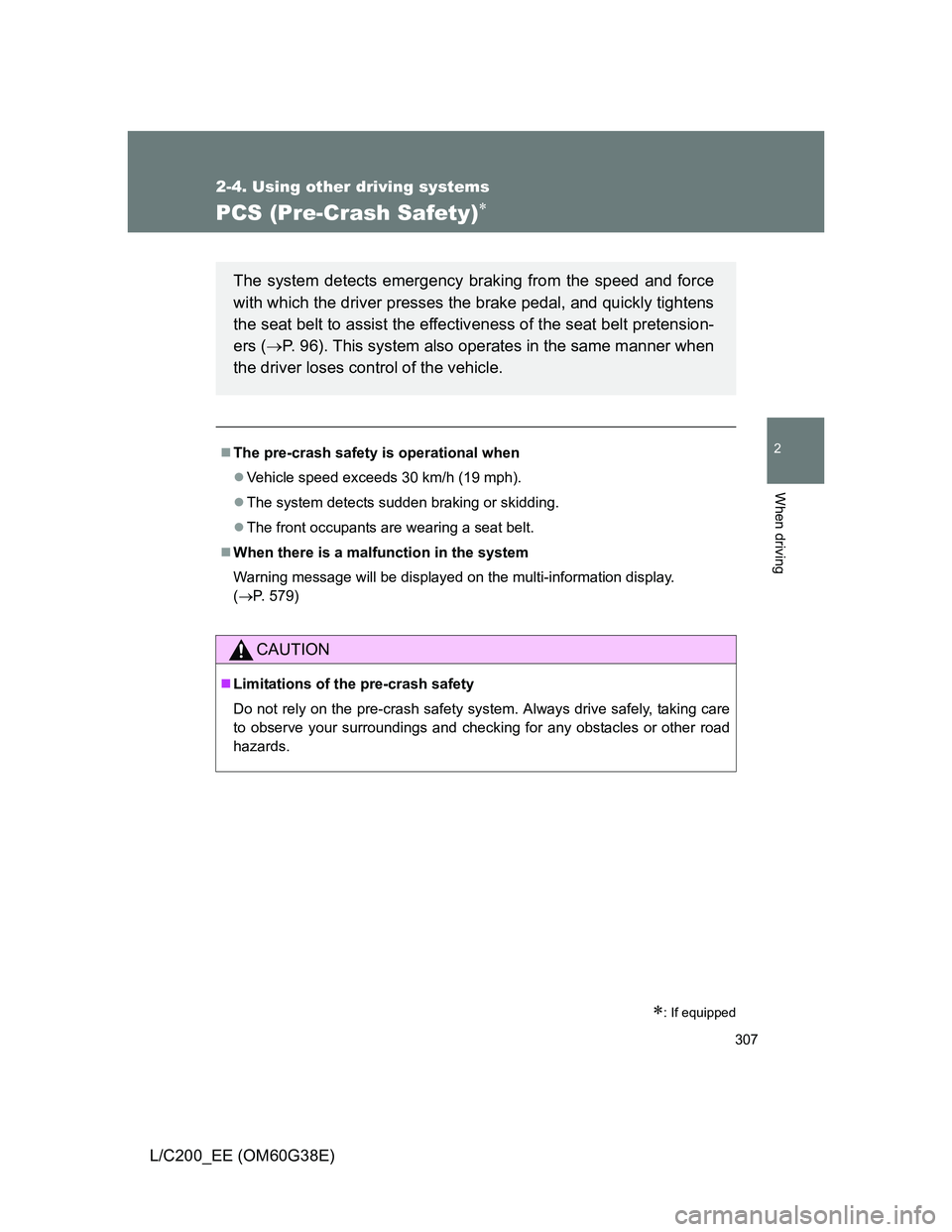
307
2-4. Using other driving systems
2
When driving
L/C200_EE (OM60G38E)
PCS (Pre-Crash Safety)
: If equipped
The pre-crash safety is operational when
Vehicle speed exceeds 30 km/h (19 mph).
The system detects sudden braking or skidding.
The front occupants are wearing a seat belt.
When there is a malfunction in the system
Warning message will be displayed on the multi-information display.
(P. 579)
CAUTION
Limitations of the pre-crash safety
Do not rely on the pre-crash safety system. Always drive safely, taking care
to observe your surroundings and checking for any obstacles or other road
hazards.
The system detects emergency braking from the speed and force
with which the driver presses the brake pedal, and quickly tightens
the seat belt to assist the effectiveness of the seat belt pretension-
ers (P. 96). This system also operates in the same manner when
the driver loses control of the vehicle.
Page 308 of 692
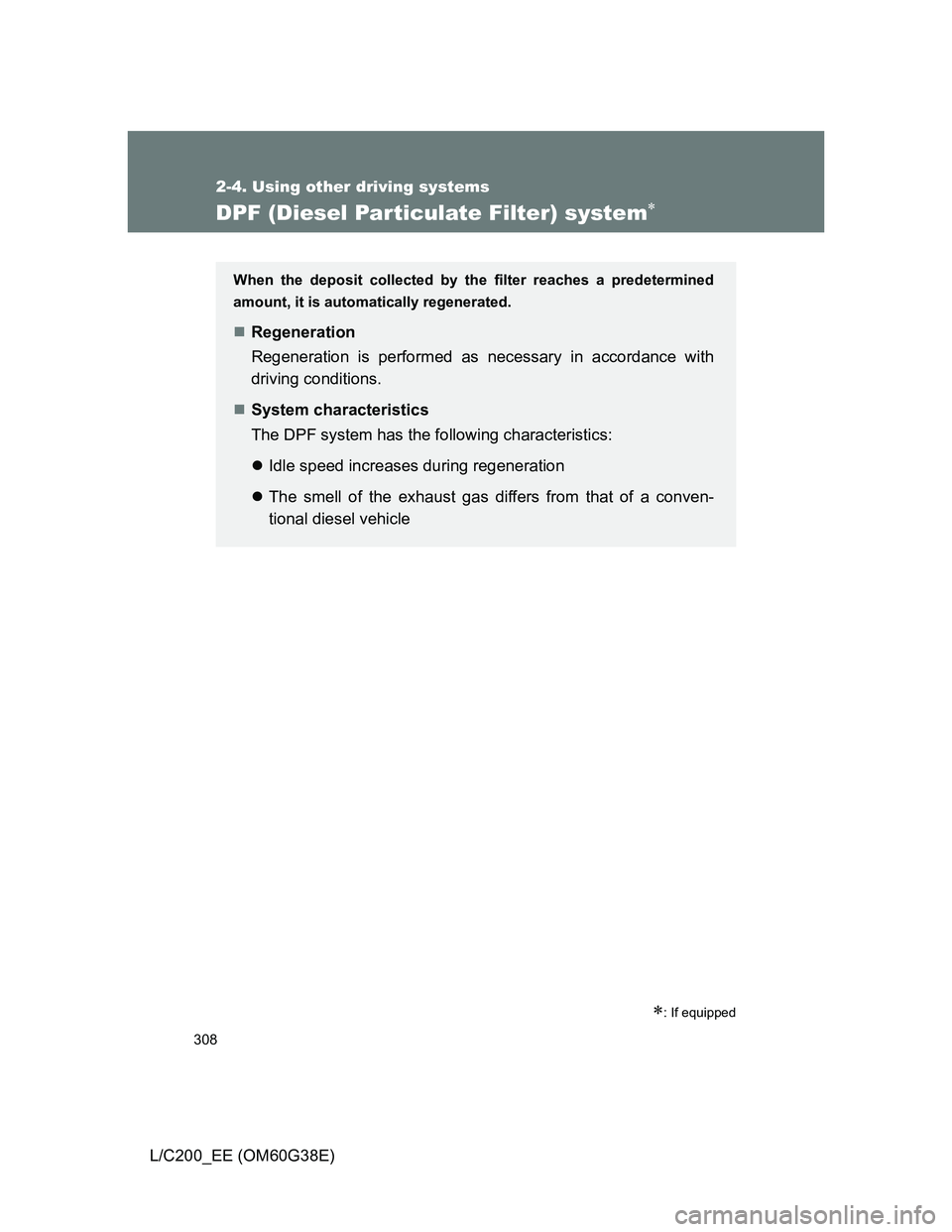
308
2-4. Using other driving systems
L/C200_EE (OM60G38E)
DPF (Diesel Particulate Filter) system
: If equipped
When the deposit collected by the filter reaches a predetermined
amount, it is automatically regenerated.
Regeneration
Regeneration is performed as necessary in accordance with
driving conditions.
System characteristics
The DPF system has the following characteristics:
Idle speed increases during regeneration
The smell of the exhaust gas differs from that of a conven-
tional diesel vehicle
Page 309 of 692
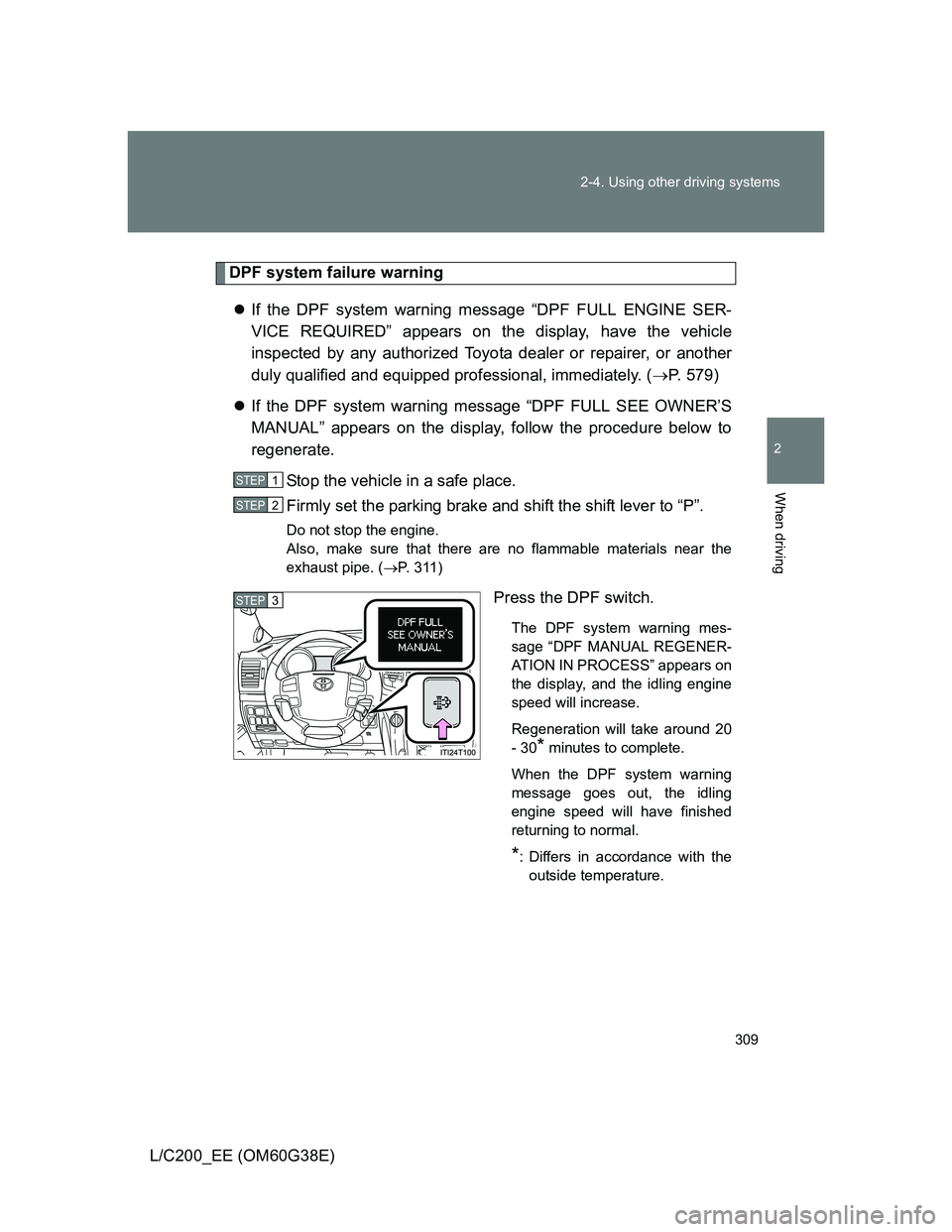
309 2-4. Using other driving systems
2
When driving
L/C200_EE (OM60G38E)
DPF system failure warning
If the DPF system warning message “DPF FULL ENGINE SER-
VICE REQUIRED” appears on the display, have the vehicle
inspected by any authorized Toyota dealer or repairer, or another
duly qualified and equipped professional, immediately. (P. 579)
If the DPF system warning message “DPF FULL SEE OWNER’S
MANUAL” appears on the display, follow the procedure below to
regenerate.
Stop the vehicle in a safe place.
Firmly set the parking brake and shift the shift lever to “P”.
Do not stop the engine.
Also, make sure that there are no flammable materials near the
exhaust pipe. (P. 311)
Press the DPF switch.
The DPF system warning mes-
sage “DPF MANUAL REGENER-
ATION IN PROCESS” appears on
the display, and the idling engine
speed will increase.
Regeneration will take around 20
- 30
* minutes to complete.
When the DPF system warning
message goes out, the idling
engine speed will have finished
returning to normal.
*: Differs in accordance with the
outside temperature.
STEP1
STEP2
STEP3
Page 310 of 692
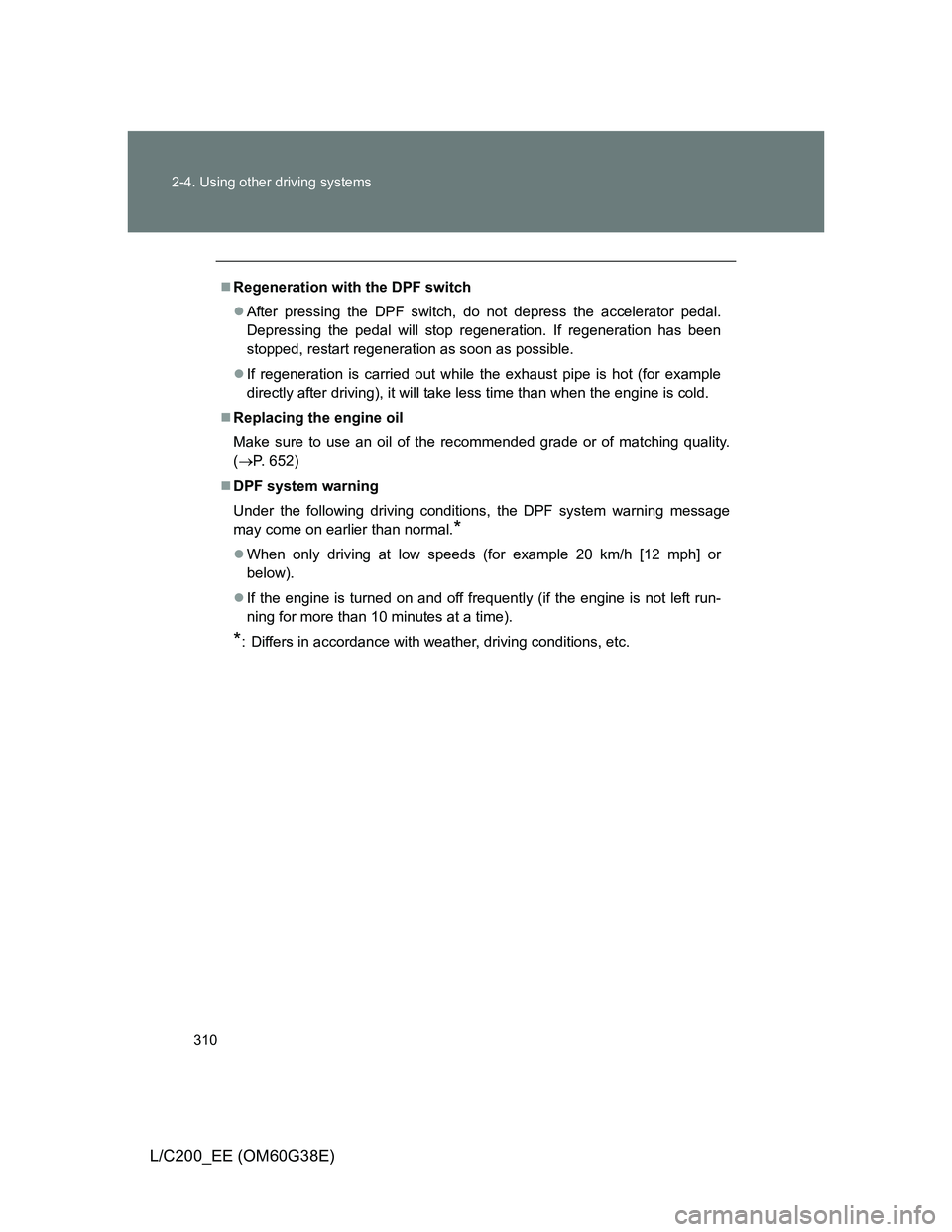
310 2-4. Using other driving systems
L/C200_EE (OM60G38E)
Regeneration with the DPF switch
After pressing the DPF switch, do not depress the accelerator pedal.
Depressing the pedal will stop regeneration. If regeneration has been
stopped, restart regeneration as soon as possible.
If regeneration is carried out while the exhaust pipe is hot (for example
directly after driving), it will take less time than when the engine is cold.
Replacing the engine oil
Make sure to use an oil of the recommended grade or of matching quality.
(P. 652)
DPF system warning
Under the following driving conditions, the DPF system warning message
may come on earlier than normal.
*
When only driving at low speeds (for example 20 km/h [12 mph] or
below).
If the engine is turned on and off frequently (if the engine is not left run-
ning for more than 10 minutes at a time).
*: Differs in accordance with weather, driving conditions, etc.